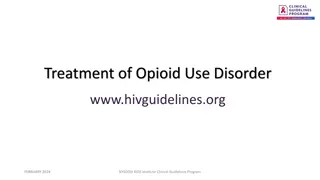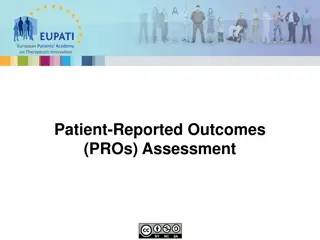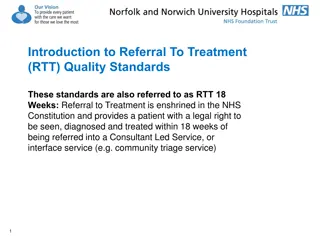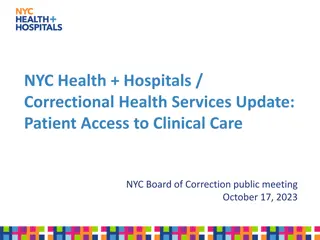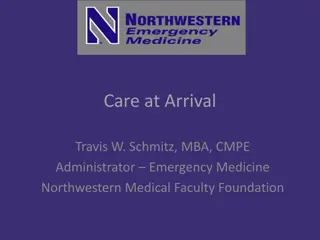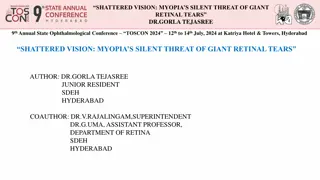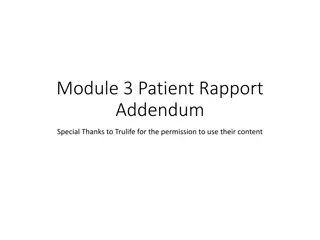Giant Prolactinomas: Treatment Approaches & Patient Management
Prolactinomas, especially giant macroprolactinomas, present with visual abnormalities, headaches, hyperprolactinemia symptoms, and potential hypopituitarism. Treatment options include dopamine agonists as first-line therapy for normalizing PRL levels, surgical interventions like transsphenoidal surgery for DA-resistant cases, and radiation therapy. Most cases are macroprolactinomas in men, with around 80% prevalence. Understanding clinical symptoms, therapy goals, and follow-up is vital in managing giant prolactinomas.
Download Presentation

Please find below an Image/Link to download the presentation.
The content on the website is provided AS IS for your information and personal use only. It may not be sold, licensed, or shared on other websites without obtaining consent from the author.If you encounter any issues during the download, it is possible that the publisher has removed the file from their server.
You are allowed to download the files provided on this website for personal or commercial use, subject to the condition that they are used lawfully. All files are the property of their respective owners.
The content on the website is provided AS IS for your information and personal use only. It may not be sold, licensed, or shared on other websites without obtaining consent from the author.
E N D
Presentation Transcript
GIANT MACROPROLACTINOMA Soheila sadeghi
Problem List in our case A 43-year-old man Progressive headache Bilateral blurred vision High Serum prolactin Level Pituitary mass in MRI
What are the appropriate treatments for Giant prolactinoma? What are the effects of different therapies in this patient? Is surgery required in the patient to be introduced? Follow up of these patients after choosing the appropriate treatment options
88 male patients = (15 micro- and 73 macroprolactinomas) Age = 40 3 14 7 years follow-up = 3 to 244 months
Clinical symptoms in men with prolactinomas usually occur as a result of tumour mass effect (visual field abnormalities and/ or headaches), together with symptoms resulting from hyperprolactinaemia (impotence and decreased libido) associated or not with hypopituitarism The goals of therapy for men with prolactinomas are to normalize serum prolactin (PRL) levels, restore gonadal and pituitary function, and decrease tumour size, especially in those patients with symptoms derived from tumour mass effect Medical management with dopamine agonists (DA) is effective and safe in men with prolactinomas, and it has been considered as first-line therapy including men bearing large macroprolactinomas Transsphenoidal surgery (TSS), radiation therapy or radiosurgery is usually reserved for patients with intolerance or resistance to DA to control tumourgrowth and hyperprolactinaemia This study shows that the majority (approximately 80%) of prolactinomas in men are macroprolactinomas (giant prolactinomas approximately 30%), with a mean age of presentation of about 40 years, without differences between micro- and macroprolactinomas
Giant prolactinoma should be defined as an adenoma with a maximum diameter of more than 4 cm that is associated with serum PRL above 1000 ng/mL In most patients, there is an association between serum PRL level and tumour volume. This association is not always consistent The hook effect is a possible cause for this discrepancy and has been reported to occur in 20% of giant prolactinomas It may be estimated to range from 0.5 to 4.4% of all pituitary tumours The majority of patients are men, with a male/female ratio of 6.5/1 In men are usually more aggressive May have clinically aggressive behaviour, including resistance to DA therapy and high recurrence rates after surgery
Different therapeutic approaches, such as DA alone or in combination with surgery (or early surgery, as indicated for patients exhibiting apoplexy with severe clinical symptoms or intracranial hypertension) and radiotherapy Medical therapy with DA is the first-line treatment for giant prolactinomas, even in patients with visual field defects Typically, 2 mg/week of CAB is sufficient to control PRL and tumour volume in patients with prolactinomas in general Regarding the type of surgery, in most cases, the transsphenoidal approach is the first choice for giant prolactinomas
Yu et al.7 evaluated surgery as first-line therapy in 18 patients with giant prolactinomas (five transsphenoidal and 13 transcranial). Complete surgical removal and PRL normalization were not observed in any patients A systematic review comparing traditional open or transsphenoidal microscopic surgery with the extended endoscopic endonasal transsphenoidal surgery for giant pituitary adenomas Furthermore, the endoscopic group had a higher rate of total resection (47% vs 31%, respectively) and better visual outcomes (91% vs 35%, respectively) than the microscopic transsphenoidal group Due to its invasiveness, total gross tumour resection is almost unfeasible
Summary of management strategies for patients with giant prolactinomas #Patients with apoplexy and severe clinical symptoms such as recent or progressive visual field defects and/or deterioration of the level of consciousness should be submitted to surgery *preference for cabergoline (CAB) **prolactin (PRL) measurement every 6 months, pituitary magnetic resonance imaging (MRI) and visual field annually *** hypogonadism treatment preferentially or surgery if the tumour load is considerable and resectable TMZ, temozolomide
Retrospective cohort study patients with macroprolactinoma between 1997 and 2011 treated exclusively with DA (bromocriptine or cabergoline) Thirty one patients aged 8 to 59 years Eighteen patients (58%) had visual impairment at the moment of diagnosis (group 1) 13 had no alterations (group 2) Mean follow up was 36.5 months Fifteen patients from group 1 (83%) had visual improvement two remained stable (11%) one had a visual deterioration (6%) In group 2, only one non-compliant patient had a visual deterioration
Retrospective follow-up study 72 patients initially treated with dopamine agonists between 1980 and 2004 : with either bromocriptine [2.5 mg/day] (n=30), quinagolide[0.075 mg/day] (n=26), cabergoline [0.5 mg/week](n=9), or terguride[0.5 mg/day] (n=7) Mean duration of follow-up was 10.2 6.1 years All patients were assessed at presentation, and, subsequently, with intervals of 6 months during prolonged follow-up Resistance was defined as failure to achieve normal prolactin levels and/or a reduction of 50% or more in tumor size by dopamine agonists Intolerance was defined as the occurrence of side effects, that made it necessary to stop dopamine agonist treatment and switch to another dopamine agonist or other treatment modalities
Dopamine agonists are the first line of therapy for macroprolactinomas, resulting in normalizing prolactin levels in 85%, inducing tumor shrinkage in 57%, and long-term remission rates in 22% of the patients Additional transsphenoidal surgery should be reserved for patients with dopamine agonist resistance or intolerance In one-third of the patients, additional therapy was necessary due to dopamine agonist resistance and/or intolerance, associated with a high incidence of hypopituitarism. Considering the high prevalence of hypopituitarism following radiotherapy, this therapy should be carefully considered, and rather be indicated for mass control than for hyperprolactinemia Although the recurrence rate is low in macroprolactinomas, these findings indicate that patients with macroprolactinomas require long-term dedicated care
Retrospective : 2009 -2015) 42 patients( a pituitary adenoma 4 cm or serum PRL > 1000 ng/mL Male were 71.4 % and younger and harbored bigger tumors compared to females
results indicated that First PRL reduction might be a sensitive predictor of tumor response to BRC intervention and be useful for further therapeutic decision in management of giant prolactinomas DAs should also be recommended to patients with compressive symptoms for that 85.7 % of cases presented visual improvement by BRC alone visual field deficits alone should not be regarded as a surgical indication for giant prolactinomas Consecutive monitoring of serum PRL levels in the early stage of initial treatment was useful for evaluation of therapeutic effects and further treatment strategy
Compared to non-giant prolactinomas, this relationship of PRL level and tumor size was usually weaker in giant prolactinomas only a half of the cases achieved normalization of PRL concentration at the last visit Although tumor remnants presented in 39 out of 42 patients, most of the remnants were well tolerated and more than 80 % of these cases showed visual field improvement after multimodal therapy
Retrospective Giant prolactinoma : median size, 4.8 cm ; median PRL, 5,927 ng/mL (71 patients ) Complete biochemical response (PRL normalization) was defined as serum PRL concentration 25 ng/mL (532 mIU/L) with at least 12 months of follow-up from the time of initial diagnosis Similarly, complete structural response was defined as no evidence of visible tumor on the follow-up MRI or at the completion of the study
Compared with those who did not undergo surgery, patients who had surgery were younger (35.0 years, [15.1 to 71.4 ]vs. 45.7 years [15.1 to 71.4 years and had lower initial serum PRL concentration (3,000 ng/mL vs. 6,920 ng/mL) but similar initial tumor size and volume Final tumor volume and volume reduction were similar in patients treated with first-line DA and patients treated with first-line surgery
Findings indicate that absence of cavernous sinus invasion was associated with complete structural response Among those with available data and sufficient follow-up, 55% of patients achieved complete biochemical response, and 26% had no visible tumor on MRI at follow-up Volume reduction of solid and cystic tumors can occur rapidly within a few days to several weeks in patients with giant prolactinoma and may lead to improvement of neurologic symptoms prior to normalization of serum PRL concentrations Surgery may be indicated in select cases such as in those presenting with pituitary apoplexy, spontaneous CSF rhinorrhea, continued tumor growth despite medical therapy, or medication intolerance.
A retrospective and multicenter study of gPRLomas in men diagnosed in a 20-year period [men= 65] The diagnosis of gPRLoma was established when the maximal tumor diameter was 40 mm or the tumor had 20 mm of suprasellar extension associated to hyperprolactinemia (PRL > 1000 ng/ml) [n=23] Non-gPRLoma was considered when tumor diameter was 10 mm and < 40 mm associated to hyperprolactinemia [n=42] follow-up period [70.5 m in non-gPRLoma vs. 48 m in gPRLoma]
At diagnosis,the only clinical difference with non-gPRLomas is their greater prevalence of visual disturbances The therapeutic approaches and tumor outcomes (control of hyperprolactinemia and tumor size reduction) were similar to those obtained in non-gPRLoma men a larger final tumor size and a higher prevalence of hypopituitarism were found in gPRLoma patients Complete cure in gPRLoma is rare, reached in less than 10 % of patients
MRI follow-up is unnecessary in patients with macroprolactinomas and long-term normal prolactin levels on dopamine agonist treatment (2017 European Society of Endocrinology) retrospective multicenter study patients with macroprolactinomas (largest diameter > 10 mm, baseline prolactin level > 100 ng/mL) treated by dopamine agonists 115 patients : 63 men and 52 women; mean age at diagnosis= 36.3 years Mean baseline prolactin level = 2224 6839 ng/mL No significant increase of tumor volume was observed during the follow-up
MRI follow-up is unnecessary in patients with macroprolactinomas and long-term normal prolactin levels on dopamine agonist treatment (2017 European Society of Endocrinology) Among 21 patients (18%) who presented asymptomatic hemorrhagic changes of the macroprolactinoma on MRI , 2 had a tumor increase (2 and 7 mm in the largest size) Both were treated by cabergoline (1 mg/week) with normal prolactin levels obtained for 6 and 24 months only 29 (25%) patients finally presented an empty sella turcica in the whole group of 101 patients who had tumor shrinkage. This means that 86 patients still had a visualized prolactinoma at the end of the study, while they had normal prolactin levels No significant increase of tumor size was observed in our patients with controlled prolactin levels on DA. MRI follow-up thus appears unnecessary in patients with biologically controlled macroprolactinomas
We recommend dopamine agonist therapy to lower prolactin levels, decrease tumor size, and restore gonadal function for patients harboring symptomatic prolactin-secreting microadenomas or macroadenomas (1| ) We recommend using cabergoline in preference to other dopamine agonists because it has higher efficacy in normalizing prolactin levels, as well as a higher frequency of pituitary tumor shrinkage (1| )
Follow-up includes: periodic prolactin measurement starting 1 month after therapy to guide treatment intensification to achieve normal prolactin level and reversal of hypogonadism 1) repeat MRI in 1 yr (or in 3 months in patients with macroprolactinoma, if prolactin levels continue to rise while patient is receiving dopaminergic agents, or if new symptoms, e.g. galactorrhea, visual disturbances, headaches, or other hormonal disorders, occur) 2) visual field examinations in patients with macroadenomas at risk of impinging the optic chiasm 3) assessment and management of comorbidities, e.g. sex-steroid-dependent bone loss, persistent galactorrhea in the face of normalized prolactin levels, and pituitary trophic hormone reserve 4)



